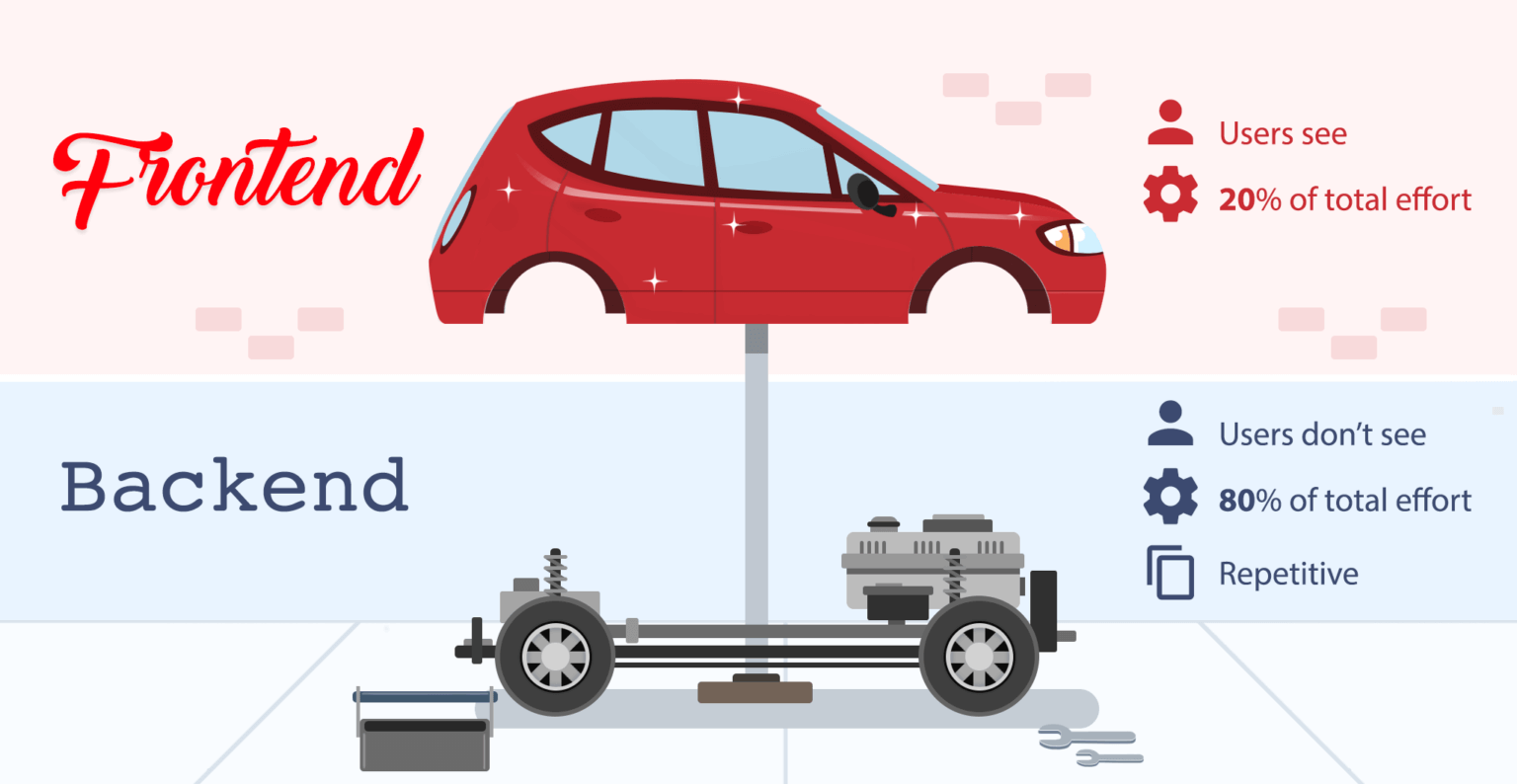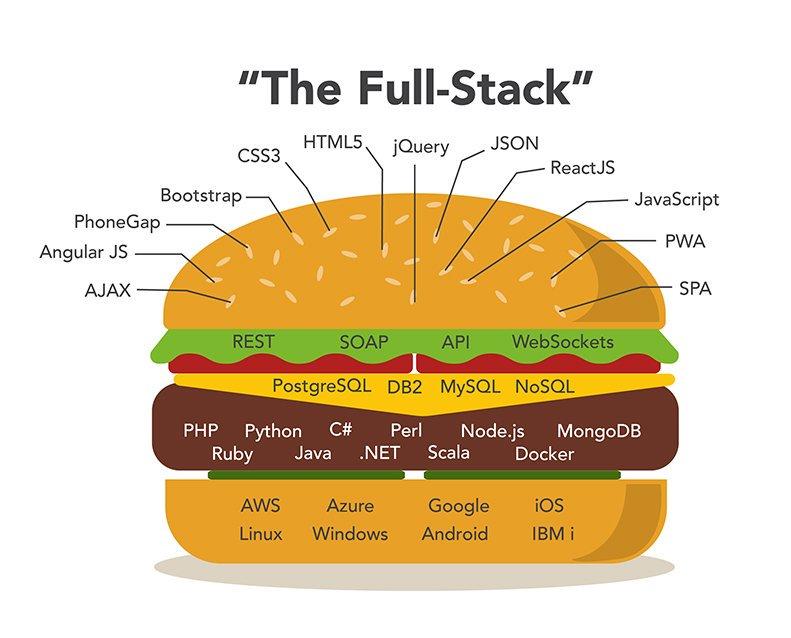How to become a Full Stack Developer in 30 Weeks?
“Companies are looking for good candidates as badly as people are looking for jobs as software developers.”

Who is a Full-Stack developer?
A full-stack developer is someone who has knowledge about 2 very important aspects of how a website or a web app functions –
- The front-end – This constitutes things and elements visible to the website visitor or user. It involves the color, the image placements, the little animations, and a lot of other aspects to it.
Front-end plays a huge role in the fraternity of full-stack development because it has to be designed, iterated, and very well thought. It needs to be fast at the same time a pleasant experience to use. This makes the front-end play a very vital role, and it’s important to take it very seriously. - The back-end – The behind-the-scenes where the website/web app communicates with the servers. These actions happen in the background with the user not having much information about what’s going on.
Example – A successful login requires validation if the credentials are right, based on the answer – A different window will open up.
Let’s have a look at what are the basic requirements for someone to become a full-stack developer who is employable.
- Good functional knowledge of HTML, CSS, and some front-end frameworks such as Bootstrap.
- A good grip over Javascript. The use of .js for both front-end and back-end has opened up vast possibilities to build fast and robust websites and web apps. So it’s great to have sound hands-on experience with javascript.
- Javascript is not just limited to web development, you can create android and ios apps using a Javascript library called React Native. You can even create standalone Desktop GUI apps using another Javascript framework known as Electron JS.
(JavaScript is also used to power backend services like Node.js. It makes it very powerful that with a grasp on one language one works on both frontend and backend applications.) - Fundamentals of DOM – Document Object Model. The Document Object Model (DOM) is a programming interface for web documents. It represents the page so that programs can change the document structure, style, and content. The DOM represents the document as nodes and objects; that way, programming languages can interact with the page.
- How to use APIs to communicate with other web apps out there. A programmer uses multiple APIs while writing functional code. The ability of an individual to read documentation, and implement APIs is a key skill to become a good developer.
- Knowledge of frameworks like React.js and the react ecosystem(There are many other frameworks such as – Angular.js, vue.js, etc, but before you jump into these – It’s good to have a foundational knowledge of javascript to play with these frameworks)
- Learning how to re-use freely available code using libraries, and other available frameworks. The knowledge to use web-packs is essential and comes in handy.
- Learning how to test the code before deploying is important because it helps a developer to find bugs, and fix them before it goes to the user
- Communicating to the server involves knowledge of frameworks like node.js, express.js. There are many other languages that are popularly used, but for someone with knowledge of javascript it becomes a little easier
- Functional knowledge of databases. Some popular choices are MongoDB, MySQL, Redis, etc
- Ability to write collaborative code – Any functional app or website is the collaborative effort of many programmers. Most of the collaboration happens using version control systems like git, bitbucket, and similar options.
- Hands-on experiences on projects where an individual has worked on writing functional code that can be put to use.

Now imagine how challenging it can get to learn so much in half a year? It is one thing to learn the basics of front-end development and back-end development, and another to be able to contribute towards building functional websites and web apps.
There is an overload of information out there where an individual can teach themselves how to code, but there are 4 fundamental challenges that prevent them from taking that leap.
For anyone to go from zero to hero in the programming world, here’s what you might need apart from all the technical knowledge mentioned above. (If you’re trying to self-educate)
- It requires you to be DISCIPLINED – This is not limited to just the profession of programming, applies everywhere
- It requires you to be DRIVEN – How bad do you want to get better?
- DIRECTION – There is information overload. Tons of free and paid resources online, but still not able to learn to code? Why?
- Getting your hands dirty – With so much of information out there, a lot of students who wish to learn to code end up only consuming the videos and binging on it.
Lack of appropriate action and deliberate practice is what often renders the wonderful resources available online not so useful for most of the candidates out there aspiring to be developers.
Let me give you an interesting insight –
“Companies are looking for good candidates as badly as people are looking for jobs as software developers”
There is a huge gap between the job seekers and the job-givers, and at Masai School, our Full-Stack Development program is designed such that a beginner can learn to code and get employed as a software developer in 30 weeks!
Our military-style program is intense -> 9 am to 9 pm 6 days a week.
- We train with you everyday (9–9–6)
- We push you everyday (9–9–6)
- We give you challenging problems to solve
- We train you on soft skills – Communication(Written/Verbal), Technical documentation, Portfolio building, Presentation skills which help you become a better professional
- Once you’re ready(30 weeks later), our 300+ partner companies come for campus placements to test your skills
- You pay us only once you get placed with a minimum package of 5 LPA
How is this possible you might ask?
This is achieved through the Pay After Placement(PAP) where our students pay us only when they get a job of 5LPA or more.
At Masai School, we have 100s of more stories of individuals who have taken the leap of faith to learn to code in a structured environment where our students undergo intense training to learn, practice and solve a lot of problems.
If you’re someone who’s looking for an opportunity to fix your broken resume, you can apply for our Full Stack Development Program.
In 30 weeks we will train you and together we will see you transform to become a software developer.
Are you ready to take the leap of faith?

